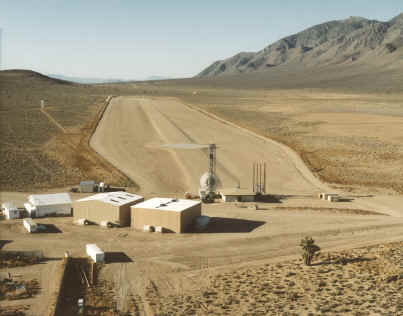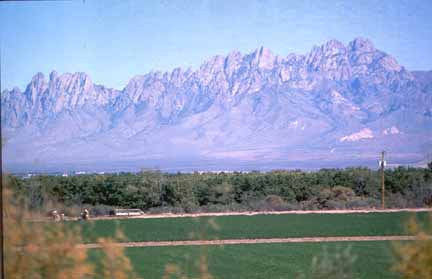SKY RAMP TECHNOLOGY
The biggest barrier to a full-scale Sky Ramp is high initial investment.
All potential sites we have studied require use of Federal parkland, political
support from locals, detailed environmental impact studies, and major infrastructure
investments. In addition, doubters and competitors will argue the idea is
unproven and therefore risky. As a result, the option of building a low cost
demonstrator to
prove this concept is more practical. There is an excellent
location, Maturango Peak (elevation 8839 ft., left) in the remote northern area
of the Navy's China Lake Test Center in California.
This provides a 4000 foot gain. An open area to build up speed, and gradual 1000 foot climb ramping up to a 3000 foot straight path at 45 degrees. This is insufficient to launch a full-scale single-stage RLV into orbit, but could launch sub-orbital RLVs, spaceplanes, or current expendable rockets into orbit at a lower cost. The location is easily accessible by road and four miles from a small radar test site called "Junction Ranch" (below). There is plenty of wide open desert at this remote and barren military test facility, and construction requires permission from no one outside the Navy.
The China Lake test sled track
was built in the 1950s and is getting old.
Therefore, a demonstrator Sky Ramp with a horizontal segment can also be used to
support aircraft and missile testing at China Lake, and provide the only steep inclined
rail launch method
in the world. There is a lot of interest in
hypersonic aircraft and this track could launch ramjet powered aircraft. Two miles of horizontal track can be used for traditional sled tests with a one mile
inclined segment acting as a natural brake that can return the sled to the
launch point.
Two miles of horizontal track can be used for traditional sled tests with a one mile
inclined segment acting as a natural brake that can return the sled to the
launch point.
One option at this location is to extend the track one mile westward up a 20 degree slope for test launches in that direction. Moreover, sleds launching craft eastward could be pushed backward up this smaller incline for launch. The sled could pick up free speed from gravity as it slides downward for one mile while sled engines fire up to shoot it two miles horizontally across the Darwin wash, then upward for one mile with the final 3000 feet a straight 45 degree track over Maturango Peak.
The best launch azimuth is eastward and 10
degrees south toward the equator and well clear of the Las Vegas area. The initial
downrange portion is the China Lake test range for dozens of miles, then the barren Death Valley
National Park, then remote Western Arizona. Even if NASA rejects
Sky Ramps, the Air Force and Navy may fund this effort for their own
purposes. The only political and local reaction will be tremendous support
for spending money for a new test track at China Lake.
Another great location for a Sky Ramp is the Organ mountains in New Mexico (left), which are mostly within the Fort Bliss training area and just southwest of the White Sands Missile range. The highest peak, Organ Needle, rises about 4000 ft. above the valley to an elevation of just over 9000 ft, with nothing downrange for a hundred miles. There are several launch azimuths to the southeast with a 3000 ft elevation gain within a mile. White Sands workers live nearby, and a White Sands spaceport already exists as an alternative landing site for the Space Shuttle. Organ peak is the southernmost of the Organs, and 22 other peaks stretch to the north over a distance of about 3 miles.
The basic goal for a Sky Ramp demonstrator is to prove that aircraft and rockets can be rail-launched at supersonic speeds off a steeply inclined ramp. The first phase should be as simple as possible. There will be no braking, so the empty sled can simply fly off the track at launch and land with a parachute. It can then be retrieved with a truck or helicopter and set back on the sled. This is so simple it cannot fail and no one can claim it will not work. This will demonstrate the advantages of rail launch in the areas of safety, simplicity, and abort. After the first rail launches prove this concept, further steps can begin:
Braking the sled - Costs can be reduced if the sled can be braked and stay on the track using huge spoilers, water cannon, and maybe a tailhook/cable system. This is possible if at least 1000 feet of track is sacrificed by releasing the craft earlier. Of course this cuts the assist. Perhaps retro rockets can cut this length, but they add weight and cost.
The other option is to extend the track curving over Maturango, which is ideal since it has a large summit. The big problem is keeping the sled from breaking out of its grips and flying off the track. The roller coaster technique of twisting the track so the sled becomes inverted and loops upside-down may work. Perhaps a large tower can be built on the peak with a tramway type cable system to trap the sled.
Sled jet engines - Standard military jet engines may be added to the legs of the sled to provide added thrust and thrust reverse for braking. They are very reliable and can be used thousands of times. Two F-22 engines can give 80,000 lbs of extra thrust, and four 160,000 lbs. They weigh around 4000lbs each, and need fuel as well. This can be done even if braking is not possible as they should withstand the parachute landings with rare problems. A jet engined test sled using commercial jet engines would also prove valuable.
Attracting Business - In addition to supporting Navy and Air Force testing, NASA may use the track to launch their X-43A hypersonic missile since the current method of captive carry aircraft and booster rockets have proven expensive and risky. NASA has not explained how it plans to launch the much larger X-43C, for which a rocket sled is ideal. The European Space Agency wants to build a miles long horizontal sled track in French Guiana to launch their HOPPER sub-orbital RLV. They may pay to use a superior inclined ramp at China Lake. The Japanese plan to launch their futuristic spaceplane off horizontal rails in Australia. They may show interest in an inclined track. Various aerospace companies are anxious to experiment with new launch techniques and may propose other ideas for using this Sky Ramp.
There is no doubt that a Sky Ramp at China Lake or White Sands will attract worldwide interest and commercial business. Both locations already have the contractors, employees, machine shops, and support equipment in place with years of experience operating their horizontal tracks. The track experts at China Lake already operate a small 3000 foot track inclined 2.8 degrees, they just need to scale that up to 20,000 feet with a 45 degree release point over Maturango Peak. White Sands workers can use their expertise with Mach 8+ sleds to throw objects into space off the Organ mountains. A Sky Ramp demonstrator at either location will generate great excitement for all types of aerospace activities.
©2010 Sky Ramp Technology